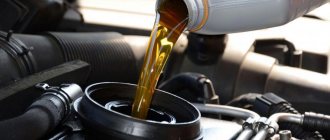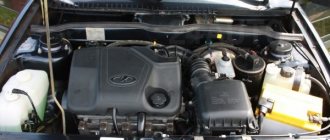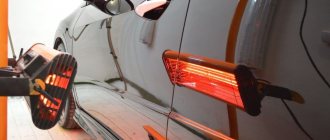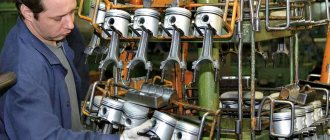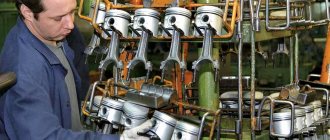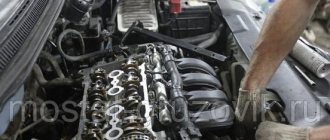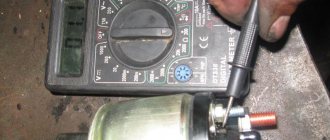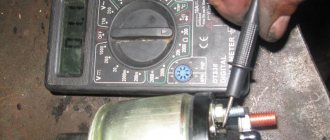Many car enthusiasts are well aware that after purchasing a new car or major overhaul of the internal combustion engine, the engine must be properly broken in. Let’s note right away that a well-performed run-in allows you to increase the engine’s life by 15-20%, improve its throttle response and efficiency.
There are several types of break-in, among which the most common are “cold” and “hot”. In the first case, an electric motor is connected to the engine, which rotates the unit without starting it. This is a cold run-in. As for the second type, the engine is run in directly on the car, that is, in motion.
As a rule, major engine repairs in many services do not involve cold running-in, since not all service stations have special stands for carrying out this procedure. This means that the car owner himself will have to break in the power unit. To do this, you need to know how to break in an engine after a major overhaul.
Proper engine running-in after overhaul
How to follow all the recommendations and not waste the work of the experts in restoring the power unit when running in the engine after a major overhaul?
Similar questions are asked, perhaps, by every car owner whose vehicle has been sent for a major overhaul of the “heart” of the car - its engine. In this article we will try to answer them. The fact is that after the overhaul is completed, it is necessary to operate the machine for some time in the so-called “gentle mode”. In each specific case, these terms and conditions are negotiated separately, but there are also a number of general rules that will not hurt anyone to follow.
Another smoking engine on video
Any car deteriorates and wears out over time, and this applies not only to the body or interior elements. Much more trouble for car owners is caused by malfunctions of the engine and other vehicle systems that arise as a result of long-term use of the vehicle.
Sooner or later, every driver is faced with the need to overhaul the power unit, which involves replacing most of the components of the cylinder-piston group and the crank mechanism. The result is an engine that has been updated almost to its original condition, which at first must be run in in the same way as a completely new car.
Of course, there are some differences, and we will definitely talk about them in our review.
Running in the engine and its life after major overhaul
The main task of running in the engine is to grind in the installed parts. Since the engine is equipped with new spare parts (rings, pistons, camshafts, etc.), it is necessary to give it a little time so that all these components get used to each other, which is especially important when replacing rings that rub against the liner.
If you run-in the engine incorrectly, or neglect it altogether, the engine life will be reduced by at least 25%.
Also, two more important factors have a great influence on the resource of the restored power unit:
- Equipment and working conditions - any service station, even with the most modern equipment, is in no way able to compete with the manufacturer in terms of equipment and technical components. Consequently, the assembly accuracy is lower than at the factory;
- Engine mileage - the parameters of those components and parts that do not change during the overhaul can no longer correspond to the original ones, since during operation they were subject to a certain natural wear and tear.
If the running-in is incorrect, in addition to a noticeable reduction in engine life, it is quite possible that engine oil will get into the air cleaner, and fuel consumption (gasoline, gas, diesel fuel) may also significantly increase, and complications with starting are also possible.
Many car owners doubt the benefits of this measure and often neglect it, wanting to save money and relying on the quality of parts (which is not always the best, especially in cases with non-original spare parts). But it is worth remembering that properly carried out running-in will significantly extend the life of the engine.
Methods for running in an engine after a major overhaul
There are 4 ways to break in a car after an engine overhaul:
- Cold running on a special stand;
- Cold running without stand;
- Hot running;
- Natural run-in.
Cold running on a special stand
This is the best option for engines that have been overhauled - this is the only way to ensure full control over the running-in process.
To drive the engine (driven) mounted in the stand, a cardan shaft is used, connecting it to the shaft of the electric motor (drive). In this case, the rotation speed of the driving motor is controlled by a special device - an encoder. A tachometer can be used for the same purpose. The whole process is controlled by a computer program, which sets the rotation speed, focusing on sensor readings.
The duration of the procedure depends on the type and volume of repair work performed. For example, to break in a newly installed cylinder-piston group, about 2 or 3 hours of cold running are required.
- stable idle speed (no more than 600 rpm);
- no interruptions in the operation of the power unit when pressing the accelerator pedal at idle. In addition, the engine should not stall.
Not everyone can carry out a test run on a stand, if only because few service stations can boast of having such a device.
Cold running without stand
For cold running-in without a stand, you need to fill the engine with oil (which oil is best to pour into the engine), and antifreeze or antifreeze into the radiator. After this, the car needs to be towed, engaging 3rd gear, but without starting the engine. The duration of the procedure is up to 2 hours.
Experts do not recommend using this break-in method, although it is very common among “garage” craftsmen.
Hot engine run-in
During hot running, you can not only check the quality of the engine assembly after a major overhaul, but also eliminate possible inaccuracies in the manufacture of spare parts. By the way, for this you do not always need to take the car to a service station, since the technology for carrying out such an event is not very complicated.
- You need to start the power unit and set the engine speed to approximately the idle mark.
- The operating time is short - up to 3 minutes, but such visits should be repeated several times, allowing the motor to cool. Otherwise, local overheating is quite possible.
- After a cycle of short-term idling, the engine is started and allowed to run for about 50 minutes. The process begins at 1200 rpm and is gradually increased to half the maximum permitted value.
If the permissible temperature is exceeded, you need to turn on the interior heater, and if this does not help, you need to turn off the power unit and give it time to cool down.
Benchless cold running
This method is some attempt to simulate the work of a running stand. The procedure is that the engine will quickly dry out if it does not heat up from the use of any fuel, and its rotation is ensured by external mechanisms.
The work is done like this: The car is coupled with a tow rope to another car and towed in gear for several hours. This makes it possible to quickly run-in the engine, but does not allow control over the operation and execution of any algorithms. How well the engine was run-in can be judged by the mileage and achievements until the next repair.
There are methods that make it possible to find out whether the engine has been successfully run-in, and when using the cold method, these signs are clearly visible:
- The car became more dynamic in motion and gained more power.
- The engine started starting much faster.
- The engine idles has become more stable and maintains speed in compliance with standard values.
Frequency of oil changes after engine overhaul
After a major overhaul, the engine oil is changed 4 times or more. The use of low-quality oil is strictly prohibited.
- The first replacement is after traveling 500 km;
- The second replacement is when the 1000 km mark is reached;
- Third replacement - 1500 km;
- Fourth change - oil is added after 2000 km.
To summarize, it can be noted that running in the engine after a major overhaul is vital, because it can significantly extend the life of the power unit.
Engine after a major overhaul - tips for running in the engine
Most car owners are aware of how the engine is broken in after a major overhaul or the purchase of a new vehicle - a necessity to make the engine more responsive and economical. Operation in a “gentle mode” (i.e., without heavy loads) increases engine life by approximately 15-20%. At the same time, the machine will achieve the performance stated by the manufacturer. Proper engine running-in after overhaul ensures restoration of 100% functionality of components and assemblies.
What is engine running-in after a major overhaul?
This is the process of running in the mating of engine parts. During break-in after an engine overhaul, the newly installed elements are subject to severe heating. New parts do not have an ideal surface: most often it is presented in the form of microdepressions, tubercles and other irregularities. The purpose of operating the machine in a “gentle” mode is to gradually smooth out problem areas, which is only possible with reduced loads on the power unit. If you do not properly break in after an engine overhaul, the following problems may occur:
- poor engine starting;
- increased fuel consumption;
- low compression;
- penetration of lubricant into the air cleaner;
- poor car acceleration dynamics.
First start of the engine after the “capital”
A very important moment. Before turning the ignition key, you need to ensure that all systems and modules provide support to the restored engine during the first break-in stage. Before starting the engine for the first time after a major overhaul, you must:
- fully charge the battery;
- check the functionality of the starter in advance (before installation);
- pour in the required volume of oil: this must be done slowly and carefully to prevent the formation of air pockets;
- Pump up gasoline in a carburetor engine and adjust the idle speed;
- If the start is carried out at sub-zero temperatures, warm up the oil and the engine itself.
When everything is ready, start the power unit and immediately pay attention to the oil pressure readings (if there is such a device). It should appear 3-4 seconds after the start of work and amount to 3.5-4 kgf/sq. see. If this is not the case, stop the engine immediately to determine the cause. At normal pressure, warm up the power plant to an operating temperature of 85-95 degrees while rotating the crankshaft at a frequency of 750-850 rpm. (it is not recommended to increase the speed by more than 60% of the nominal value). At the same time, inspect the engine from all sides for oil and coolant leaks.
The appearance of small and short-lived smoke under the hood should not cause concern: the process of combustion of oil that accidentally got inside during assembly of the unit is in progress. When the radiator fan turns on, turn off the engine and let it cool to 30-40 degrees. Then run it again and repeat 15-20 times. Only after this can you begin running in after the overhaul.
Around the bend
Yes, friends, sometimes troubles happen that entail a major overhaul of the engine or, more simply put, a major overhaul. Just like a new engine that has been overhauled by motorists, it also needs competent running-in with an understanding of the essence of the issue. Unfortunately, both in the case of a new engine and in the case of a rebuilt one, many motorists are completely unaware of such a process as break-in.
Since our resource is aimed primarily at novice motorists, we will not go into technical issues with a bunch of incomprehensible words, but will consider the case when your car had an engine overhaul, but was not really explained what to do afterwards. Unfortunately, this is exactly what happens in many cases, which was the reason for writing this note. So, let's go.
The 1st stage is very important. In fact, you determine the future “life” of the engine with it. For the first two stages, you just need to forget about at least some noticeable load on the engine. Simply put, it should operate at 60% load compared to normal operation. For simplicity, let's highlight a few points here:
- Regularly checking the levels of working fluids (in this case, it is the engine low and the coolant level).
- Good warm up to operating temperature. If you are wondering why you need to warm up the engine before driving, I recommend reading a note on the topic. Well, if we are talking about the process of running in the engine after a major overhaul, then there cannot be any “buts”. It definitely needs heating. And not just up to 40-50°C, but up to the operating temperature, which is approximately 84-93°C.
- Smooth start and smoothest braking.
- Smooth and accurate operation of the gas pedal.
- Constant monitoring of engine speed, which in run-in mode should not exceed 3000 rpm.
- Engine temperature monitoring.
- Availability of a supply of engine oil and coolant in the trunk. Although this should always be with you, or rather with your car.
- Do not transport heavy loads, much less a trailer.
This is interesting: Re-registration of a social tenancy agreement for another person in 2021
Stage 2 is the most difficult. Its difficulty is that if it is not so difficult to withstand 500 km, then another 2000 or more can already begin to cause irritation. But we have something to endure for. It’s very good if at this stage you have a need to visit your grandmother in another city and a significant part of it will fall on this route. In the summer this is easier, although in the summer heat it is harder on the engine. In general, if it works out, good. No - oh well, go about your business, just always remember to be extremely careful and smooth.
Some advise driving long distances at a stable speed during the break-in period, while others, on the contrary, recommend letting the engine run in different modes. Let's still choose something in between and without fanaticism, because despite all the importance, this is not the most important thing in your life. You are not for the car, but the car is for you.
As a conclusion, I would like to say once again that engine overhaul is not a reason to sell a car. It may happen that a restored motor will last you much longer than a new one, as is very often the case. In general, my advice to you is to treat this issue philosophically, just like others. “Nothing lasts forever under the sun,” including you and me and our cars. Regular inspection of the car, elimination of minor faults, use of high-quality spare parts and consumables is the key to the health of your iron friend!
And yes, do not forget to hang a sign on the back with the large inscription “BREAK-IN” while the engine is running in after the overhaul. This way, you won’t irritate other drivers with your sluggish acceleration and leisurely maneuvers, and you will be treated with understanding.
How long to break in the engine and how to do it
The first 1000 km are considered the most important. During this period, it is not recommended to travel at speeds above 60 km/h: it is better not to engage fifth speed at all. During the initial run-in, bluish smoke may appear from the muffler pipe: there is no need to panic: this is natural, since new piston rings are being broken in. Unstable idle is also not a reason to worry. Adjustment should be done after 500-1000 km. How long does it take to break in the engine in total? After the car has traveled 2.5-3 thousand km, increase the maximum speed to 85-90 km/h, gradually increasing the load. The engine can be considered finally run-in after running 8-10 thousand km.
Oil selection and frequency of replacement
It is worth considering in more detail the issue of replacing lubricating consumables after a power plant overhaul. First, this must be done after 500 km. Then after 1000 and the last time after 2000 km. Use high-quality motor oil recommended by the manufacturer. After the specified kilometers have been covered, drain the used mixture and flush the engine. When running in, take into account the oil viscosity:
- in summer 15W40;
- in winter 5W30;
- in the intermediate season: 10
After the “overhaul”, when the vehicle has completed its first 350 km and the oil needs to be changed, it is recommended:
- install a new oil filter;
- adjust valve clearances;
- inspect and, if necessary, tighten the timing belt or chain.
Features of diesel running-in
There are no fundamental differences here from the same procedure with a gasoline unit. There are only a few nuances. First of all, this is the duration of the run-in: ultimately, it should be at least 10-12 thousand kilometers. Only after covering such a distance can the diesel engine be operated at maximum loads. Another important point when running in a diesel engine after a major overhaul is turning off the engine after stopping. This cannot be done right away: you need to let the diesel engine run for several tens of seconds - this requirement is especially relevant for turbocharged engines. As for changing the oil, this needs to be done every 500 km. After the first half a thousand km, replace the lubrication system filter, adjust the timing belt (including the belt or chain drive), and tighten the cylinder head bolts. When breaking in a car, do not use synthetics - it can only be filled in after the final grinding in of parts - after 3 thousand km. When running in summer, use oil M-10G2K (15W-30), in winter - M-10DM or M-8G2. It is worth noting that for a diesel engine, the best running-in option is to use bench equipment in a service station, where the process is “cold”. In this case, the duration of the run-in is at least 3 hours.
Use lubricants with low viscosity: this will improve the quality of lapping of parts. Sometimes in stores you can find special, so-called. “break-in” oil, which contains special additives that speed up the break-in process.
Case from practice
The engine “smoke” after repair, and the mechanic says something about grinding in the valves, about changes in the properties of the oil and that all problems will go away on their own... Such statements must be answered with the question: can a new car “smoke”? If oil is consumed, it means the valves are not ground in. But it’s not a fact that they will get used to it after the first “thousand”.
This shouldn't happen
As for oils, everything is clear: even on engines where only synthetics are suitable, during break-in they use material without modifiers. We are talking about break-in oils. And nothing should smoke when using them.
Ideally, everything looks like this:
- Replaced (rebuilt, repaired) the engine;
- When they started it, it “smoked”, and even a lot;
- The engine ran for 20 minutes, and the revolutions could reach up to 3000. And the problem gradually disappeared.
Anything else will be a “deviation from the norm.” And perhaps this deviation is caused by some defect.
Running in the engine after a major overhaul
Engine running-in is performed in cases where the engine has just been released by the manufacturer or after a major overhaul. Engine running-in usually lasts 2–3 thousand kilometers.
Compliance with the engine break-in regime is necessary due to the fact that new parts require “grinding in”. New engine parts are manufactured using cutting tools, and even with 100% compliance with their manufacturing technology, it is not possible to obtain absolutely smooth surfaces. All the same, after processing, when examined under a microscope, you will see not a smooth surface, but a surface similar to a mountain landscape.
During the “grinding in” of parts, micro-irregularities collide with each other and are smoothed out. This process is accompanied by increased friction and temperature, which is why it is necessary to observe the engine break-in regime and use special anti-scuff drugs. It is known that the service life of an incorrectly run-in engine is no more than 30% of a normally run-in one, and a well-run-in engine will serve you for several hundred thousand kilometers.
The main purpose of break-in is to smooth out micro-irregularities with minimal load on the engine.
Before the start
When releasing a new car, the manufacturer could pour “mineral water” or “semi-synthetic” into the engine. The same should be used during break-in. Do you want to remove the coating layer in the cylinders? Then you can immediately fill in synthetics, “hydrocracking” and the like.
Viscosity of “synthetic” and “mineral” at 100 C
If the pressure is reduced, the running-in is stopped immediately. By the way, before the start you can check the oil level on the dipstick.
The lamp with the “oil can” should go out 5-6 seconds after starting the engine.
First engine start after major overhaul
1. Please note that the car battery must be 100% charged, otherwise it will not be able to handle the first cranking. 2. Use high-quality motor oil, filling it to the upper limit of the dipstick. After filling, wait at least 5-10 minutes for the oil to drain into the pan. Do not fill the oil filter with oil to avoid air lock. 3. If the engine is carburetor or diesel, where there is no fuel pump, pump the fuel manually. 4 . Start the engine with the starter, monitoring the oil pressure (on the dashboard). If after 3-4 seconds the low oil pressure lamp does not go out, immediately turn off the car and eliminate the cause of the low oil pressure. Do not press on the accelerator pedal; this is harmful - the load and lack of oil will quickly and irrevocably damage the surfaces of the parts. 5. If the oil pressure is OK, warm up the engine to 85-93 C. Constantly check for possible leaks of technical fluids. You should not worry if there is a burning smell or slight smoke; the cause of their occurrence is the process of burning out assembly lubricants. As the coolant temperature rises, the oil pressure should drop due to the oil becoming thinner. The permissible value of oil pressure is within 0.4-0.8 kg/cm2. If this is not the case, then errors were made during assembly (the clearances are incorrect, the oil pump is faulty or the quality of the oil is poor). 6. Turn off the engine, wait until the engine temperature reaches 30-40 degrees, then start the engine again and let it warm up at idle. 15-20 such cycles , after which you proceed to running in at higher speeds. 7. Running in at high speeds - keep 1000 revolutions for 3 minutes, 1500 for 4 minutes, 2000 for 5 minutes.
Options for running in a diesel engine
During major work, worn parts are replaced. To operate the engine at full power, all rubbing working elements must be perfectly coordinated. The proper running-in process ensures that parts are ground in and maximum performance is achieved.
Rules for running the engine at home
For factory engines, the running-in process is carried out on special equipment, under the guidance of qualified workers.
To do the work yourself you need:
- Check the level and condition of the electrolyte in the battery; if necessary, bring it to the required standards.
- View starter status. After a major overhaul, the diesel engine will be difficult to crank, so the starter should turn the crankshaft without delay.
- Replace the oil system filter.
- Using a dipstick, check the oil in the engine crankcase and, if necessary, add to the upper mark. Use only the best quality oil.
- Next, if there is no electric fuel pump, fill the fuel system manually.
- Depending on the ambient temperature, you need to adjust the cooling system damper. In winter, you need to warm the crankcase with a heating pad.
- Start the engine, while monitoring the oil pressure and watching the indicators on the instrument panel. The first start usually takes longer, this is due to the filling of the fuel supply system.
- The pressure on the pressure gauge should be in the range of 3.5 - 4 kg / cm2. After reaching this mark, continue warming up at idle speed.
- Next, turn on the radiator cooling fan for a few minutes and turn off the car.
After cooling the power unit to 40 degrees, we begin warming up again. The procedure must be repeated 10-15 times. After fulfilling all the requirements, we begin to run in at medium speeds. To do this, hold 1000 rpm for 3 minutes. After that, we gradually increase it to 1500 and 2000 rpm.
At each mark we linger for 5 minutes. Then you can start running in on the go. The operating instructions for a particular vehicle indicate its required speed limits.
Break-in rules
- the speed limit should be within 60-70 km/h. Driving in high gears is prohibited;
- after 3 km. mileage, you can start adjusting the speed;
- do not overload the car. Maximum load acceptable after traveling 10 thousand km;
- start driving only when the vehicle is warm;
- alternate speed gears. During this period, the formation of efficiency and smooth operation of the engine occurs, therefore driving only at high or low speeds is prohibited;
- Do not allow a sharp decrease in revolutions and speed. It is better to run-in outside the city or in the evening;
- On modifications with turbocharging, it is not recommended to immediately turn off the engine; you need to idle for some time.
Run-in mode after major overhaul
8. After this, you can drive out onto the road. At the same time, do not exceed the speed of 60-70 km per hour . It is better not to engage fifth gear during this period. The first 300-500 km are the most critical, do not overload the engine. The appearance of bluish smoke from the muffler is a normal situation, especially if a new set of piston rings is installed. There may also be some instability in the idle speed, which should be finely adjusted after 500-1000 km . 9. After 2500-3000 km , the maximum speed can be increased to 80-90 km/h.
to change the oil and filter after a run of 2500 km During this period, many wear products appear in the oil.
After changing the oil, do not forget to also tighten the accessible threaded connections (cylinder head, oil pan, front cover, starter, generator, etc.), adjust the valve clearances, idle speed, and timing belt (chain) tension. When extraneous noises and knocks appear, you must definitely find their source.
These simple operations will allow you to properly break in your car's engine. The most common mistake during break-in is running in high gears and, accordingly, low engine speeds - this cannot be done, because At this time, the engine is overloaded due to insufficient oil pressure.
Signs of improper break-in: oil in the air cleaner, high fuel consumption, low power, oil consumption, problems starting the engine.
As you can see, the running-in process requires precise implementation of the technology. To avoid possible problems with engine break-in, manufacturers use special break-in additives, such as WINDIGO ECO-Universal Oil Package. The additive will ensure ideal “grinding in” of surfaces, protect new parts from scuffing, and your investment in major repairs will ensure a long service life of the overhauled engine. The use of WINDIGO additives during break-in allows you to reduce the break-in time by 2 times, as well as avoid possible problems with “grinding” and jamming of engine parts. Additives also eliminate scuffing that has occurred on the surface of parts if the engine has not been run in correctly.
Why change the oil after break-in?
It doesn't matter at all what engine is installed on the car. It will still have a break-in period. During this very period, all the parts inside the engine and gearbox are ground in. It is easy to guess that because of this, micro chips are produced from the ground elements of the engine.
Micro chips in engine oil
These micro chips will not initially affect the operation of the car. It will fall into the pan, mix with oil and simply “furrow” along the friction units. Only in the future, if you do not get rid of these chips in time, will the service life of the engine be reduced significantly. Micro chips will get to the pair of crankshaft or camshaft bearings. These parts are already overloaded when the motor is running, and the presence of chips makes the load critical. It is because of this that parts begin to wear out prematurely. And this is only in the first thousand kilometers.
In addition, micro chips clog the oil supply channels, which can even cause an engine breakdown in the middle of the road.
Definitely, you need to change the oil after break-in . This is very important, because otherwise you risk sending your recently purchased car for repairs.
On the left is regular car oil, on the right is oil after running the car, which has turned black during use.
At the same time, there is no clear answer to the question of when exactly to change the oil. The fact is that everything depends directly on the manufacturer and model of the car. For example, the manufacturer of the Mazda 3.6 recommends changing the oil after the first 1500 - 3000 kilometers. But the Ford Focus documentation states that the first replacement should be carried out in the car after 20 thousand kilometers.
So you shouldn’t rush to change the oil immediately after the first thousand kilometers . First you need to take an interest in the recommendations of the manufacturer itself. After all, each car model has an individual engine and its own channel structure. The grinding process itself during break-in is also different.
Different car models have different break-in times, so you need to find out about oil change intervals in the documentation.
There are cars that do not suffer at all from running in and all the parts are practically tailored to each other, which is why micro chips are minimal and will not affect the smooth operation of the engine in any way. Car dealers will tell you if your model has this feature.

